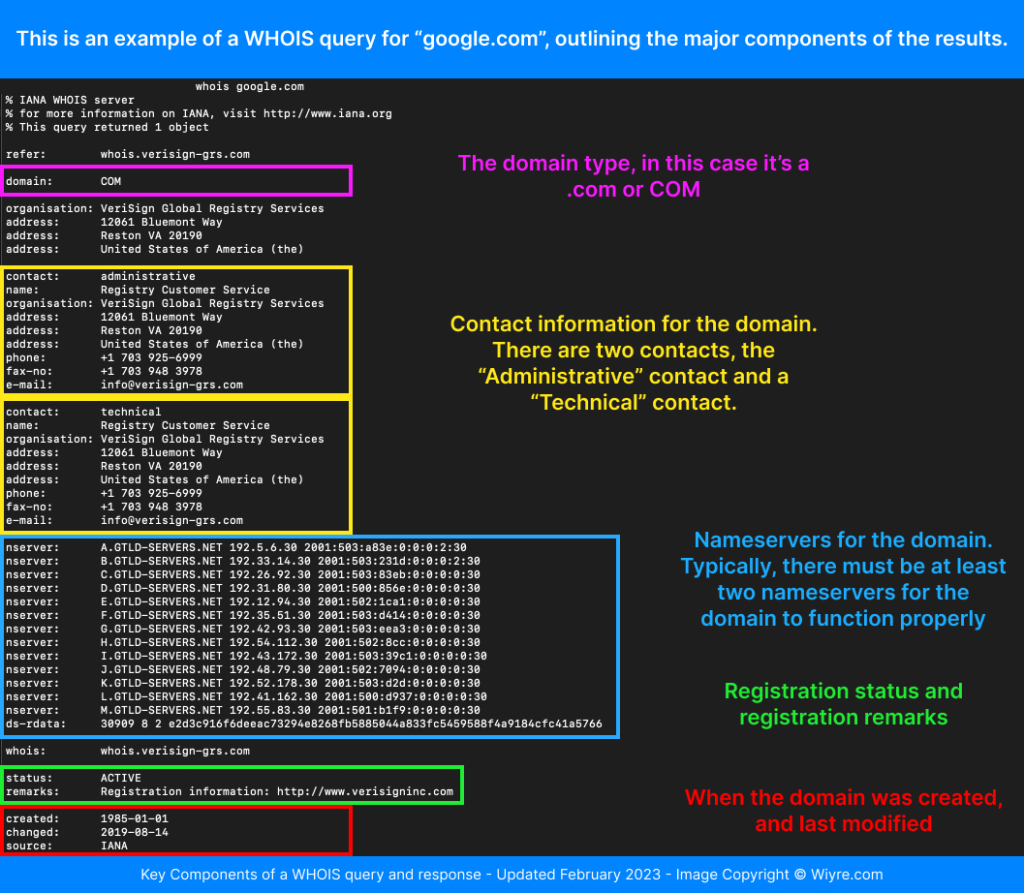WHOIS (pronounced “Who is”) is a query and response internet protocol that is widely used for querying databases that store the registered users or assignees of an Internet resource, such as a domain name, an IP address block, or an autonomous system. In more simple terms, WHOIS data is used to identify and track the registration of domains, as well as to identify domain name owners. You can think of WHOIS like a “phone book for the internet”.
History of WHOIS
As a means to provide a central database of registered domain names and associated information, WHOIS was developed in 1982 by the Internet Engineering Task Force as a simple way to quarry domain names or IP addresses. Over the years the protocol has been updated and the current version now allows for more complex queries and contains more information that the version that was released in the ’80s.
Purpose of WHOIS
The primary use of WHOIS is to identify the owner and contact information of a domain name. WHOIS can also be used to check the status of a domain name, find out when it was registered, and when it is set to expire. It is also a useful tool to check if a domain name is available for registration. WHOIS data has also become an invaluable tool for law enforcement agencies to track malicious actors and illegal activities. Here’s what the FBI had to say about WHOIS data:
American law enforcement agencies query WHOIS data tens of thousands of times a day, not only to investigate crimes, but also to identify suspects, witnesses, and victims. Investigators also rely on WHOIS to combat fraud and deceptive practices.
FBI Associate Deputy Attorney General Sujit Raman – Source
Key components of WHOIS data

Domain Name
This is the name associated with a specific website. Generally, it is a combination of the name of the website and the domain suffix, such as .com, .org, or .net – but it can include just “COM” or the top-level domain.
Registrant and Contact Information
The Registrant and Contact Information data in a WHOIS query is the name and contact information associated with the person or organization that registered the domain name. It usually includes the name of the registrant, their postal address, phone number, and email address. In some cases, organizations will register domains on behalf of their customers for privacy reasons. In the phone above, the VeriSign company is serving as the contact for all domain-related inquiries for Google.com.
Administrative and Technical Contact Information
This is the name and contact information of the person responsible for managing the domain name, such as the webmaster, web developers, web designers, content managers, system administrators, or any other random administrators assigned to the task. It usually includes the name of the contact person, their postal address, phone number, and email address.
Registrar Information
This is the name and contact information of the registrar that processed the registration of the domain name. It usually includes the name of the registrar, their postal address, phone number, and email address. Popular domain name registrar options include Cloudflare, NameCheap, and Google Domains, which all provide a paid registrar service.
Limitations and Challenges of WHOIS
WHOIS data is self-reported, meaning the accuracy of the data relies heavily on the user (or the person who registers the domain). This can lead to inaccurate or incomplete records or records that are simply out of date. In certain cases, the information you would typically expect to find on WHOIS is not available due to the domain registrar limiting access to certain records, meaning that the data may not be as accessible as you might expect. This is typically referred to as “WHOIS privacy” and is a service (usually offered for a fee) by the registrar.
Conclusion
In conclusion, WHOIS has been an integral part of the internet since its early inception, and it continues to play an important role in the management of domain name registration and maintenance. While WHOIS has been a valuable tool for network administrators, it also has some limitations and concerns when it comes to privacy issues, incomplete or incorrect data, and limited access. Despite these drawbacks, WHOIS remains a useful tool for those who need to manage domain names, IP addresses, and registrars.
Frequently Asked Questions
You can look up WHOIS data for any website by using a free WHOIS lookup tool or through a command-line terminal on your computer. On a Mac, you can open the Terminal program and type “whois <domainname>” to retrieve WHOIS data.
The privacy of WHOIS data is country dependent. Many countries have private WHOIS data which means that only the registrar or the domain owner can view the WHOIS data. In other countries, WHOIS data is publicly available. In the United States WHOIS data is public and is available to anyone who wants to access it.
WHOIS privacy is an added service offered by some domain name registrars that mask the personal contact information of the domain owner. WHOIS privacy is an effective way to keep information private and protect the domain owner from spam, identity theft, and other forms of cybercrime.
